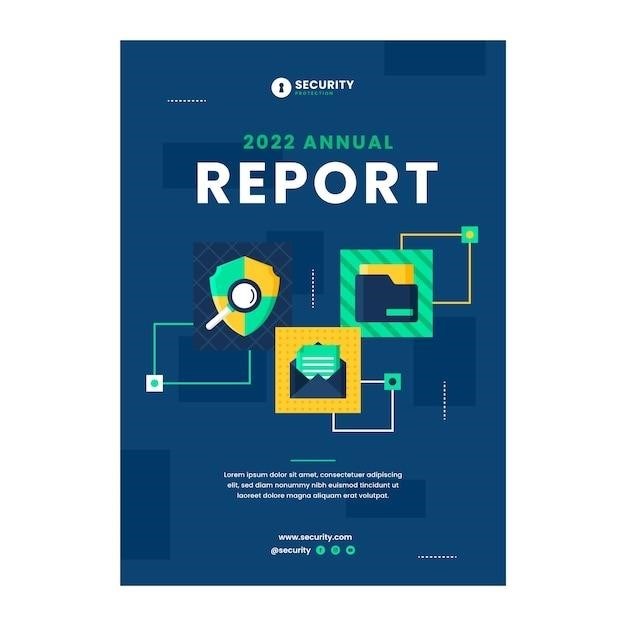Investigation Report Template PDF⁚ A Comprehensive Guide
This guide explores the creation and utilization of investigation report templates in PDF format. We’ll cover various template types, essential elements for effective reports, information organization strategies, and best practices for writing clear, concise, and legally compliant documents. Learn how to leverage software and tools to streamline your reporting process.
Types of Investigation Report Templates
Investigation report templates cater to a wide array of needs, each designed to suit specific contexts and purposes. For instance, a workplace investigation might necessitate a template focusing on employee misconduct, harassment claims, or safety violations. These often include sections for witness statements, timelines, and disciplinary recommendations. Conversely, an accident investigation report template prioritizes factual details surrounding an incident, emphasizing the sequence of events, contributing factors, and preventative measures. Templates for criminal investigations, frequently used by law enforcement, differ significantly, adhering to legal requirements and incorporating evidence collection procedures. Furthermore, internal audits might utilize templates to document findings related to compliance issues, financial irregularities, or operational inefficiencies. The choice of template hinges upon the nature of the investigation, the relevant regulations, and the information required for a thorough and conclusive report. Regardless of the specific type, a well-structured template ensures consistency and clarity, facilitating efficient information gathering and analysis.
Key Elements of an Effective Template
An effective investigation report template hinges on several crucial elements to ensure clarity, comprehensiveness, and legal soundness. A well-defined structure is paramount, typically including sections for a concise executive summary, detailed background information outlining the scope of the investigation and the involved parties, a chronological account of events supported by documented evidence, interviews conducted with relevant individuals, and a thorough analysis of findings. The inclusion of relevant supporting documents, such as photographs, emails, or witness statements, is crucial. A clear and unambiguous presentation of conclusions, free from subjective interpretations, is essential. Moreover, recommendations for corrective actions or preventative measures should be clearly articulated. Finally, the report should maintain a consistent and professional tone, using precise language to avoid ambiguity. Adherence to legal and compliance guidelines, relevant to the investigation type, is critical, ensuring the report’s admissibility and legal defensibility. Overall, a well-designed template streamlines the investigation process, yielding a comprehensive and actionable report.

Organizing Information for Clarity
Organizing information within an investigation report template is crucial for ensuring clarity and facilitating easy comprehension. A logical flow, moving from the general to the specific, enhances readability. Begin with a concise executive summary providing a brief overview of the investigation’s findings and recommendations. Next, present the background information, setting the context for the investigation. This section should clearly identify the subject, the individuals involved, and the initial allegations or concerns. The subsequent sections should present a chronological account of the events, using clear headings and subheadings to divide information into manageable chunks. Each event or piece of evidence should be documented thoroughly and objectively, referencing any supporting documents or interviews. Maintain consistent formatting throughout the report, using bullet points, numbered lists, and tables where appropriate to improve readability. Visual aids, such as charts or diagrams, can be used to present complex data more effectively. Finally, ensure a clear separation between factual information and interpretations or conclusions, maintaining objectivity and avoiding bias. A well-organized report enhances its credibility and persuasive power.
Essential Sections of an Investigation Report
A comprehensive investigation report template necessitates several key sections to ensure thoroughness and clarity. The introduction should clearly state the report’s purpose, scope, and methodology. It should define the subject of the investigation and identify the individuals or entities involved. A detailed methodology section explains the investigative steps undertaken, including interviews conducted, documents reviewed, and data analyzed. This enhances transparency and allows readers to understand the basis of the conclusions. The findings section presents the factual evidence gathered during the investigation, avoiding subjective interpretations or opinions. It should objectively present all relevant information, including both supporting and contradicting evidence. The analysis section interprets the presented evidence, drawing conclusions based on the findings. This is where connections between the facts are made and potential explanations are offered. The conclusions section summarizes the key findings and analysis, clearly stating the report’s overall conclusions. Recommendations, if appropriate, should propose actions or solutions based on the investigation’s findings. Finally, a concise summary reiterates the key conclusions and recommendations, offering a quick overview for busy readers. All sections should maintain a professional and objective tone, avoiding emotional language or personal biases.

Examples of Investigation Report Templates
Numerous investigation report templates cater to diverse needs. For workplace misconduct, a template might include sections for detailing the complaint, witnesses’ statements, investigative procedures, findings, and disciplinary actions. Accident investigation reports often incorporate sections for describing the incident, identifying contributing factors, and recommending preventative measures. Financial fraud investigations necessitate templates with sections for outlining the alleged fraud, tracing financial transactions, identifying perpetrators, and quantifying losses. Templates for criminal investigations typically include sections for documenting evidence, witness testimonies, and the chain of custody. Furthermore, templates exist for internal investigations, encompassing sections for outlining the complaint, conducting interviews, analyzing evidence, and determining appropriate actions. Regardless of the specific template used, consistency in formatting, clear headings, and a logical flow are crucial. The best template will adapt to the specific circumstances of each investigation, ensuring all relevant information is captured and presented effectively. The use of a pre-designed template streamlines the process, promoting efficiency and accuracy in reporting.
Utilizing Different File Formats (PDF, Word, etc.)
The choice of file format for an investigation report template significantly impacts its usability and accessibility. PDF (Portable Document Format) offers advantages in preserving formatting and ensuring consistent appearance across different devices and operating systems. This makes PDFs ideal for formal reports requiring a professional and unchanging presentation. However, PDFs are less flexible for collaborative editing; revisions typically require creating a new version. Microsoft Word (.doc or .docx) offers greater editing flexibility, allowing multiple users to collaborate on a single document. This is beneficial for ongoing investigations where updates and revisions are frequent. However, Word documents can experience formatting inconsistencies across different versions of the software or operating systems. Other formats like Google Docs offer real-time collaboration features and accessibility across various platforms, potentially enhancing team work, but might require specific software or internet access. The ideal format depends on the specific needs of the investigation and the level of collaboration required. Consider factors such as the need for version control, ease of editing, and the recipient’s access to specific software when choosing a file format for your investigation report template.
Legal and Compliance Considerations
Legal and compliance requirements significantly influence the structure and content of investigation reports. Adherence to data privacy regulations, such as GDPR or CCPA, is paramount. Personal information must be handled responsibly, often requiring redaction or anonymization to protect individual privacy. Legal counsel should be consulted to ensure the report’s language and content are legally sound and avoid potential liability. Depending on the nature of the investigation, specific legal frameworks might govern the process and reporting requirements. For instance, workplace investigations may need to comply with employment laws and anti-discrimination regulations. Similarly, investigations involving financial misconduct may need to meet stringent auditing standards. The report must accurately reflect the investigation’s scope and methodology, avoiding biases or misrepresentations. Maintaining a clear chain of custody for evidence is also crucial. The report should clearly document the evidence gathered, its source, and any handling procedures; Failure to comply with legal and ethical standards can result in legal challenges, reputational damage, and significant financial consequences. A well-structured template helps maintain compliance by providing a framework that incorporates these crucial considerations.
Best Practices for Writing a Report
Crafting a compelling and effective investigation report demands adherence to specific best practices. Clarity and conciseness are paramount; avoid jargon and overly technical language, ensuring the report is easily understood by all readers regardless of their technical expertise. Maintain a neutral and objective tone, presenting facts without personal bias or subjective interpretations. Each statement should be supported by credible evidence, meticulously documented and referenced within the report. This strengthens the report’s credibility and allows for easy verification. A logical structure is essential, typically starting with an executive summary, followed by a detailed account of the investigation’s methodology, findings, and conclusions. Use headings, subheadings, and bullet points to enhance readability and guide the reader through the information seamlessly. Pay close attention to formatting; consistent font styles, margins, and pagination ensure professionalism. Proofread carefully for grammatical errors and typos, as these can undermine the report’s credibility. Regularly back up your work to prevent data loss. Consider using a template to maintain consistency and ensure all necessary sections are included. A well-written report is a powerful tool for informed decision-making, conflict resolution, and accountability.
Software and Tools for Investigation Reports
Numerous software applications and tools can significantly enhance the creation and management of investigation reports, particularly in PDF format. Word processing software like Microsoft Word or Google Docs provides basic functionalities for text formatting, image insertion, and table creation. However, for more advanced features and streamlined workflows, dedicated case management software solutions offer robust capabilities. These often include features for evidence management, interview scheduling, report generation, and collaboration tools for team-based investigations. Consider software with built-in PDF export functionality for easy distribution and archival. Spreadsheet software, such as Microsoft Excel or Google Sheets, is beneficial for organizing and analyzing numerical data, facilitating the creation of charts and graphs for visual representation within the report. For complex investigations involving large datasets or intricate visualizations, specialized data analysis tools might be necessary. Remember to choose software compatible with your existing infrastructure and capable of handling the volume and type of data involved in your investigations. Furthermore, utilizing cloud-based storage and collaboration platforms ensures data security, easy access, and efficient teamwork. The selection of appropriate tools directly impacts the efficiency and professionalism of the investigation process.
